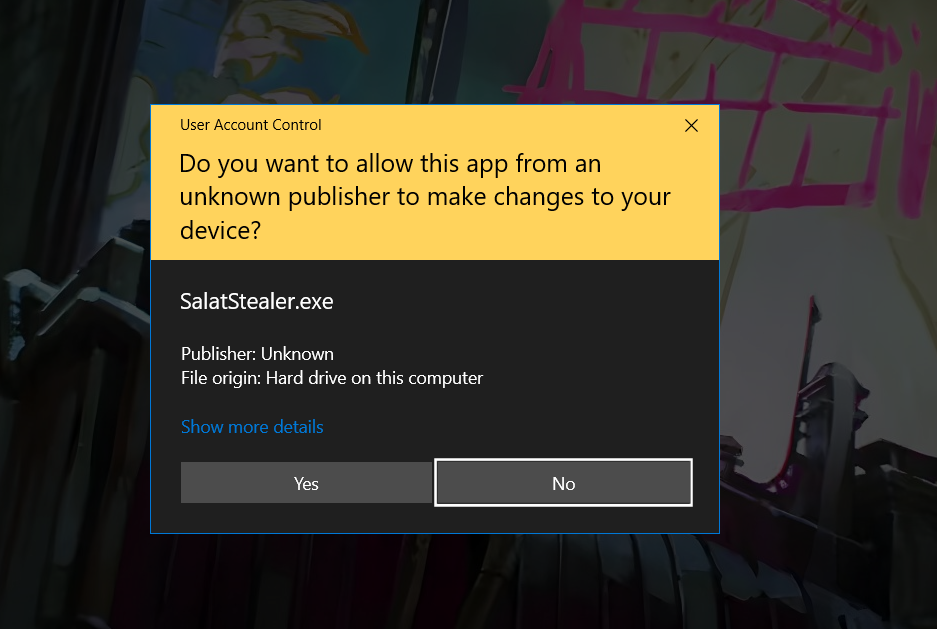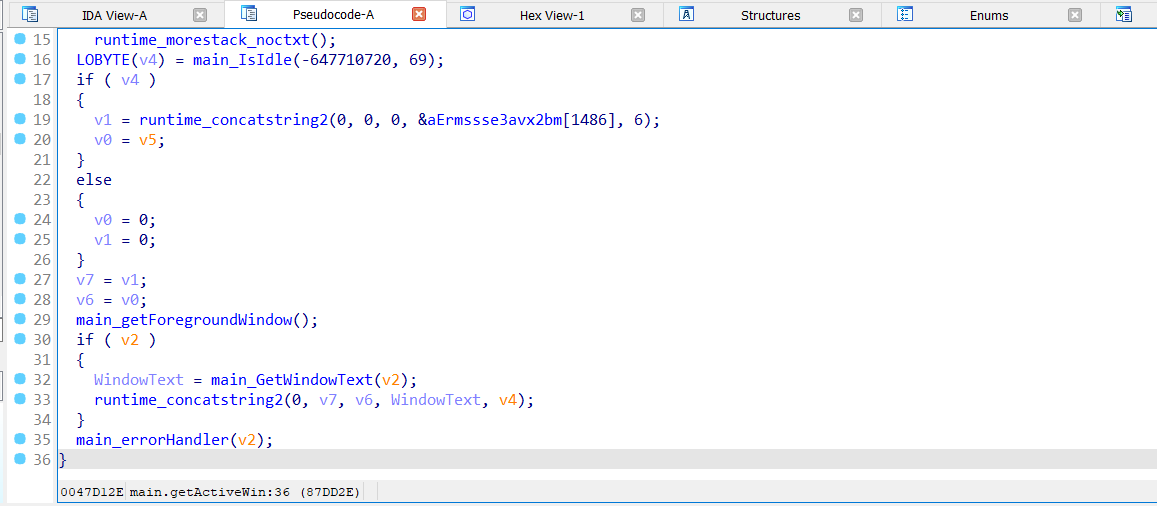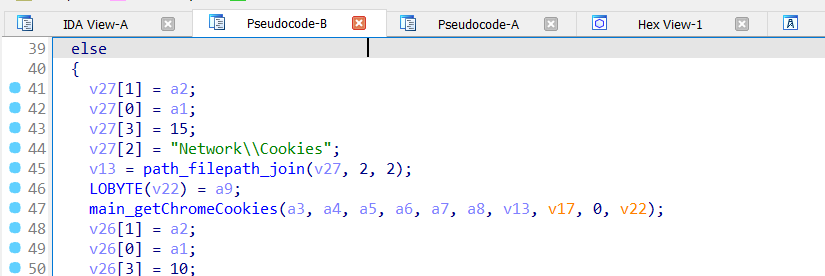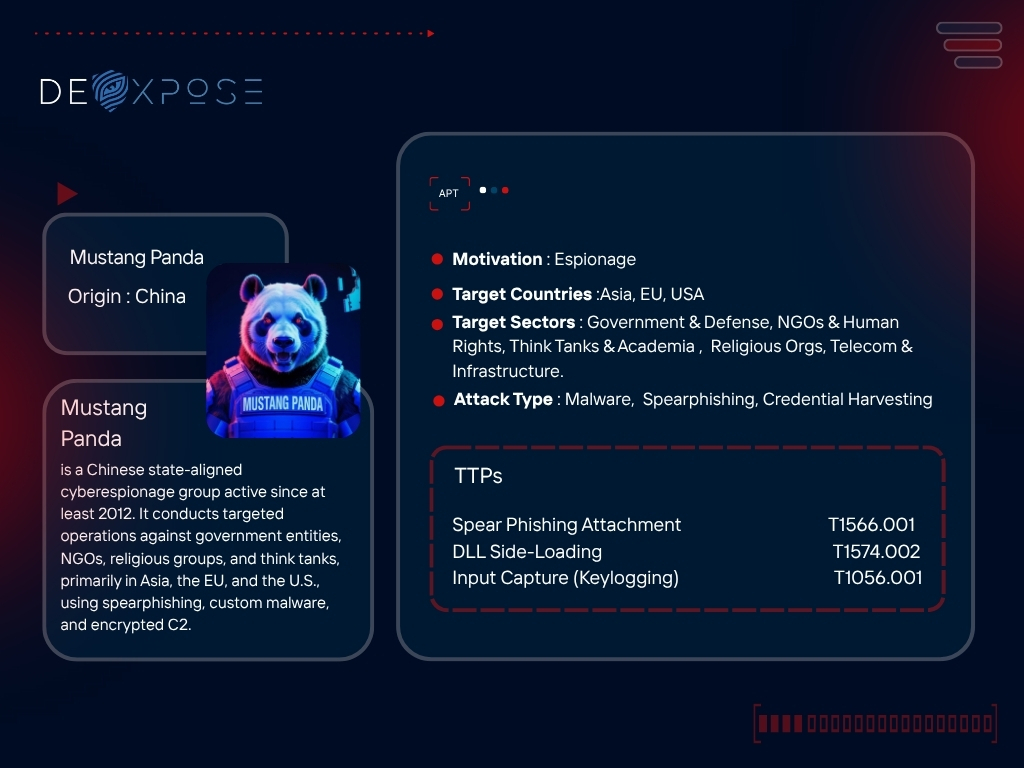Introduction
Salat Stealer is a stealthy malware developed in the Go programming language, designed to infiltrate systems and extract sensitive data. Once it infects a device, it gathers extensive system information, such as hard drive details, screen resolution, running processes, and active windows. One of its most alarming features is its ability to live-stream the victim’s desktop and capture audio and video using the device’s microphone and camera, creating serious privacy concerns. Furthermore, Salat Stealer is capable of exfiltrating files from the compromised machine. Its presence can result in significant risks, including identity theft, financial loss, and severe breaches of privacy.
Capabilities and Functionality
Data Theft and Credential Harvesting
• Gathers stored credentials from web browsers (e.g., Chrome, Firefox, Edge).
• Extracts login credentials from local email clients.
• Accesses cryptocurrency wallet files to steal private keys or funds.
• Searches for unsecured credentials stored in plaintext files.
• Exfiltrates files from the compromised system, potentially leading to severe privacy breaches, financial loss, and identity theft.
Live Desktop Monitoring
• Possesses live-streaming capabilities, allowing attackers to monitor the victim’s desktop activity in real time.
• Can record audio and video through the device’s microphone and camera, posing serious privacy risks.
Persistence and Evasion Techniques
• Writes files to critical system directories (Windows, System32, Drivers, Program Files)
• Modifies Windows Registry (Run key) to ensure automatic execution at startup.
• Uses User Account Control (UAC) bypass techniques to escalate privileges.
• Executes dropped payloads to extend its attack chain.
• Employs UPX packing to obfuscate its code and evade signature-based detection.
Attack Chain Overview
- Initial Infection:
- Distributed through phishing emails, malicious attachments, and drive-by downloads.
- Can also be delivered via cracked software or trojanized applications.
- Execution and Persistence:
- The malware executes upon user interaction, such as opening a malicious file.
- It abuses the Windows Registry (Run key) to achieve persistence.
- Attempts to bypass User Account Control (UAC) for elevated privileges.
- System Reconnaissance & Data Collection:
- Enumerates running processes and active windows.
- Scans for stored credentials in web browsers, email clients, and cryptocurrency wallets.
- Checks system language settings to potentially avoid infecting specific regions.
- Data Exfiltration:
- Extracted credentials and system details are sent to an attacker-controlled command-and-control (C2) server.
- The malware may attempt to remove traces of its activity to avoid detection.
UPX Packing
All known Salat Stealer samples discovered so far have been packed using the UPX packer.

To unpack it just easily use upx -d file_name

During static analysis of the Salat Stealer binary, multiple hardcoded strings were found, indicating targeted applications, including cryptocurrency wallets and web browsers.


User Account Control (UAC) Bypass
SalatStealer employs User Account Control (UAC) bypass techniques to gain elevated privileges without alerting the user. By setting EnableLUA key in \REGISTRY\MACHINE\SOFTWARE\Microsoft\Windows\CurrentVersion\Policies\System\EnableLUA to “0” (Disables UAC).
By setting EnableLUA to 0, the malware disables UAC enforcement, allowing it to execute administrative commands and maintain persistence while bypassing security restrictions. However, this change does not take effect immediately—a system reboot is required for UAC to be fully disabled. Until the system restarts, the UAC prompt will still appear when executing the malware.

Persistence Mechanism of SalatStealer
SalatStealer establishes persistence by copying itself in random directories, in my case it copied it self in:
- C:\Program Files (x86)\Windows Defender\
- C:\Program Files (x86)\Windows NT\
It then creates Run keys in the Windows Registry to ensure execution at startup:
\REGISTRY\USER\<USER_SID>\SOFTWARE\Microsoft\Windows\CurrentVersion\Run\smss = “C:\\Program Files (x86)\\Windows Defender\\smss.exe”
\REGISTRY\USER\<USER_SID>\SOFTWARE\Microsoft\Windows\CurrentVersion\Run\dllhost = “C:\\Program Files (x86)\\Windows NT\\dllhost.exe”
Targeted Data by SalatStealer
SalatStealer retrieves hardware identifier (HWID) for the system.
It calls golang_org_x_sys_windows_registry_OpenKey() with: HKEY_LOCAL_MACHINE\SOFTWARE\Microsoft\Cryptography as argument


This is where MachineGuid is stored, which is commonly used for HWID tracking.
Then it calls golang_org_x_sys_windows_registry_Key_GetStringValue to retrieve MachineGuid value

Capturing Active Window
main_getActiveWin is responsible for capturing the title of the currently active window to track user activity. It first checks if the system is idle using main_IsIdle(), likely to avoid detection or log only meaningful interactions. If not idle, it retrieves the active window handle via main_getForegroundWindow() and extracts the window title using main_GetWindowText().

Targeted Web Browsers
Salat Stealer aims to extract stored credentials, cookies, and session data from the following browsers:
Chrome
Firefox
Mercury
Thorium
Iridium
Vivaldi
Orbitum
Maxthon
K-Meleon
Sputnik
Slimjet
Opera GX
SeaMonkey
IceDragon (Comodo)
Pale Moon
DCBrowser
Waterfox
BlackHawk
Cyberfox
Chedot
Kometa
Fenrir
Coowon
Liebao
Dragon (Comodo Dragon)
CocCoc
Yandex Browser
Chrome SxS
360Browser
UR Browser
It extracts the following data:
- Cookies
- Saved Login Credentials
- Authentication Tokens
- Extensions


Targeted Cryptocurrency Wallets
Salat Stealer specifically targets multiple crypto wallets to steal private keys including:
Metamask
TonKeeper
SuiWallet
Coinomi
Binance Wallet
Martian Wallet
Phantom Wallet
SafePal Wallet
Solfare Wallet
Enkrypt Wallet
Exodus Wallet
Guarda Wallet
Bitapp Wallet
Coin98 Wallet
Fewcha Wallet
Finnie Wallet
Iconex Wallet
Kaikas Wallet
Oxygen Wallet
Pontem Wallet
Saturn Wallet
Sollet Wallet
Wombat Wallet
Starcoin Wallet
Electrum Wallet
MyMonero Wallet
Crocobit Wallet
PaliWallet
ExodusWeb3
Armory
XinPay
XMR.PT
Atomic Wallet
Jaxx Wallet
Targeted Messaging Applications
Telegram Desktop
Kotatogram
Screen and Live Desktop Monitoring
Salat Stealer can continuously capture screenshots and even stream the victim’s desktop live to the attacker’s command-and-control (C2) server, providing real-time visibility into their activities.
Clipboard Data Theft
Salat actively monitors clipboard activity, allowing it to intercept copied text, including passwords, cryptocurrency addresses, and other sensitive data.
Keylogging – Keystroke Interception
Salat Stealer records everything typed on the victim’s system, capturing credentials, messages, and any other input in real-time.
Audio and Video Espionage
Salat Stealer functions as a full-fledged spyware tool, capable of:
Microphone Recording: Capturing and transmitting audio from the victim’s microphone.
Webcam Access: Recording video from the system’s webcam.
Live Streaming: Broadcasting real-time audio and video feeds to the attacker’s remote server.
Exfiltration
Salat Stealer employs a stealthy exfiltration process to transmit stolen data to its C2 server, using AES encryption to obfuscate sensitive information before transmission. Files are bundled into ZIP archives
Conclusion
SalatStealer is a stealthy and persistent malware designed to steal sensitive data while evading detection. By harvesting credentials, exfiltrating files, and enabling real-time surveillance, it poses severe risks to victims, including financial loss, identity theft, and privacy breaches. Its use of UAC bypass and registry modifications, making removal difficult. Additionally, its encryption mechanisms and UPX packing further complicate analysis and detection. Given its broad targeting of web browsers, cryptocurrency wallets, and messaging applications, SalatStealer remains a significant threat, emphasizing the need for continuous monitoring and advanced security measures to counter its impact.
IOCs
IP: 104[.]21[.]84[.]111
Hash:
e2797eec2f82e9f93bed5c70adacecab791441199814ae333c45c7bf1c70ab6b
cfdf1d2768ed773c3f5b2c2a03d7892551ea79b181068c23a765f1e09a8c90b1
52a1750dc75795faa2bfdd3405ee027ee7a4fe78928027a5439372312479ca33
57d78bce936c22b62291e2b13868b7513e174eede90ddb40a0d8d5609d041e78
e2c1f8f1db1d2c47bbe60e2d4daf5422865639bcafca1933c9f807e353d98e5b
Registry:
\REGISTRY\USER\USER_SID\SOFTWARE\Microsoft\Windows\CurrentVersion\Run\smss = "C:\\Program Files (x86)\\Windows Defender\\smss.exe"
\REGISTRY\USER\USER_SID\SOFTWARE\Microsoft\Windows\CurrentVersion\Run\dllhost = "C:\\Program Files (x86)\\Windows NT\\dllhost.exe"
\REGISTRY\MACHINE\SOFTWARE\Microsoft\Windows\CurrentVersion\Policies\System\EnableLUA = "0"
Yara Rule
rule Detect_SalatStealer_MEMORY
{
meta:
author = "Dexpose Team"
date = "2025-03-12"
description = "Detects SalatStealer in Memory"
version = "1.1"
sharing = "TLP:CLEAR"
hash1 = "e2797eec2f82e9f93bed5c70adacecab791441199814ae333c45c7bf1c70ab6b"
hash2 = "cfdf1d2768ed773c3f5b2c2a03d7892551ea79b181068c23a765f1e09a8c90b1"
hash3 = "52a1750dc75795faa2bfdd3405ee027ee7a4fe78928027a5439372312479ca33"
hash4 = "57d78bce936c22b62291e2b13868b7513e174eede90ddb40a0d8d5609d041e78"
hash5 = "e2c1f8f1db1d2c47bbe60e2d4daf5422865639bcafca1933c9f807e353d98e5b"
strings:
$hex1 = {
89 41 4C 89 0C 24 E8 ?? ?? ?? ?? 8B 44 24 04 8B 4C 24 08 85 C0 74 ??
C7 44 24 20 00 00 00 00 C7 44 24 24 00 00 00 00 C7 44 24 28 00 00 00 00
C7 44 24 2C 00 00 00 00 8D 15 ?? ?? ?? ?? 89 54 24 20 8D 15 ?? ?? ?? ??
89 54 24 24 74 ?? 8B 40 04
}
// mov [ecx+4Ch], eax
// mov [esp+3Ch+var_3C], ecx ; _ptr_exec_Cmd
// call os_exec__ptr_Cmd_Start
// mov eax, [esp+3Ch+var_38]
// mov ecx, dword ptr [esp+3Ch+var_34]
// test eax, eax
// jz short loc_XXXXXX
// mov [esp+3Ch+var_1C], 0
// mov [esp+3Ch+var_18], 0
// mov [esp+3Ch+var_14], 0
// mov [esp+3Ch+var_10], 0
// lea edx, RTYPE_string
// mov [esp+3Ch+var_1C], edx
// lea edx, "An error occurred"
// mov [esp+3Ch+var_18], edx
// jz short loc_XXXXXX
// mov eax, [eax+4]
$hex2 = {
E8 ?? 7? 00 00 8B 44 24 28 8B 4C 24 24 8B 54 24 30 89 94 24 ?? 03 00 00 8B 5C 24
3C 89 9C 24 ?4 02 00 00 8B 6C 24 ?? 89 AC 24 AC 0? 00 00 8B 74 24 ??}
// call main_getChrome
// mov eax, [esp+718h+var_6F0]
// mov ecx, [esp+718h+var_6F4]
// mov edx, [esp+718h+var_6E8]
// mov [esp+718h+var_3EC], edx
// mov ebx, [esp+718h+var_6DC]
// mov [esp+718h+var_464], ebx
// mov ebp, [esp+718h+var_6E4]
// mov [esp+718h+var_56C], ebp
// Partial wildcard for unknown instruction
// mov esi, [esp+718h+var_6D8]
condition:
uint16(0) == 0x5A4D and
filesize > 10MB and filesize < 12MB and
all of them
}
MITRE ATT&CK Techniques
| Tactic | Technique ID | Technique Name |
|---|---|---|
| Boot or Logon Autostart Execution | T1547 | Registry Run Keys / Startup Folder |
| Privilege Escalation | T1547.001 | Abuse Elevation Control Mechanism |
| Defense Evasion | T1548 | Bypass User Account Control |
| Defense Evasion | T1548.002 | Boot or Logon Autostart Execution |
| Impair Defenses | T1562 | Disable or Modify Tools |
| Impair Defenses | T1562.001 | Modify Registry |
| Credential Access | T1555 | Credentials from Password Stores |
| Credential Access | T1555.003 | Credentials from Web Browsers |
| Unsecured Credentials | T1552 | Credentials In Files |
| Unsecured Credentials | T1552.001 | Credentials In Files |
| Discovery | T1614 | System Location Discovery |
| Discovery | T1614.001 | System Language Discovery |
| Collection | T1005 | Data from Local System |



